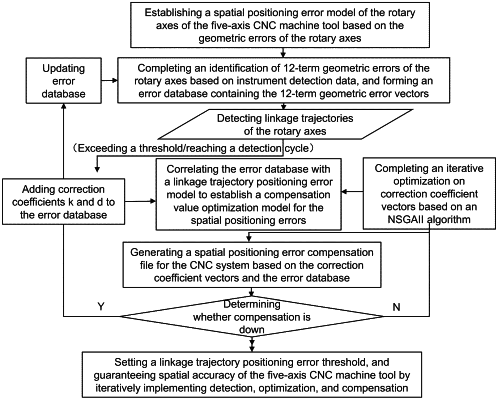| CPC G05B 19/404 (2013.01) [G05B 2219/32333 (2013.01)] | 9 Claims |

|
1. A method of optimization and compensation for volumetric positioning errors of rotary axes of a five-axis computer numerical control (CNC) machine tool, comprising:
(1) establishing a volumetric positioning error model for the rotary axes of the five-axis CNC machine tool based on 12 geometric errors of the rotary axes, wherein the rotary axes at least include a rotary axis A that rotates around an X-axis and a rotary axis C that rotates around a Z-axis;
(2) completing an identification of the 12 geometric errors of the rotary axes based on instrument detection data, and forming an error database containing 12 geometric error vectors;
obtaining a geometric error identification result by performing the identification of the 12 geometric errors using a detection instrument and a relevant identification algorithm based on the volumetric positioning error model established for the rotary axes of the five-axis CNC machine tool based on step (1); wherein
each of the 12 geometric error vectors is an error vector combined by 6 geometric errors identified for each rotary axis of the rotary axis A and the rotary axis C:
 wherein (δx(A), δy(A), δz(A)) denotes a displacement error of the rotary axis A along an X-direction, a Y-direction, and a Z-direction, respectively, (δx(C), δy(C), δz(C)) denotes a displacement error of the rotary axis C along the X-direction, the Y-direction, and the Z-direction, respectively, (θα(A), θβ(A), θγ(A)) denotes an angular error of the rotary axis A around the X-axis, a Y-axis, and the Z-axis, respectively, and (θα(C), θβ(C), θγ(C)) denotes an angular error of the rotary axis C around the X-axis, the Y-axis, and the Z-axis, respectively;
the 12 geometric errors are related to a motion position, and each of the 12 geometric errors is turned into a vector related to the motion position, i.e., when a motion stroke of each rotary axis is divided into N equal parts, a same error element is slightly different at different rotation angle positions, which is noted as:
 where EbaseN×12 denotes a matrix of N rows and 12 columns, which is a geometric error database of the five-axis CNC machine tool;
(3) decomposing the volumetric positioning errors of the rotary axes into linear correlation and nonlinear correlation, and constructing a volumetric positioning error compensation table of the rotary axes of a CNC system by combining with a sag error compensation function of the CNC system;
(4) adding correction coefficients k and d to the geometric error database obtained in step (2) and correlating the correction coefficients k and d with the volumetric positioning error model for the rotary axes to establish a compensation data optimization model for the volumetric positioning errors of the five-axis CNC machine tool;
(5) carrying out compensation quality control on correction coefficient vectors K and D composed of the correction coefficients k and d based on a non-dominated sorting genetic algorithm (NSGAII algorithm) so as to complete an iterative optimization of compensation data to realize an optimization of the correction coefficients;
(6) generating a volumetric positioning error compensation file for the CNC system by using the correction coefficient vectors obtained in step (5) and the error database containing 12 geometric errors, so as to complete compensation of the 12 geometric errors of the rotary axes of the five-axis CNC machine tool; and
(7) updating geometric error correction data to the error database, and periodically detecting linkage trajectories of the rotary axes, and setting a linkage trajectory positioning error threshold, thereby guaranteeing spatial accuracy of the five-axis CNC machine tool by iteratively implementing detection, optimization, and compensation.
|